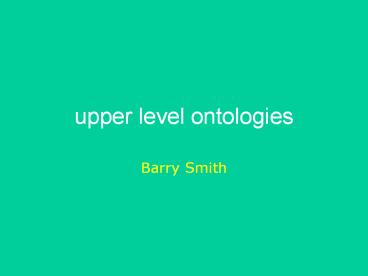upper level ontologies PowerPoint PPT Presentation
1 / 29
Title: upper level ontologies
1
upper level ontologies
- Barry Smith
2
Suggested Upper Merged Ontology
3
Imagine...your view of the web
4
...and the Computer's View
Slide inspired by Frank von Harmelan
5
Wait, we've got semantics -
6
Suggested Upper Merged Ontology
- 1000 terms, 4000 axioms, 750 rules
- Associated domain ontologies totalling 20,000
terms and 60,000 axioms - includes ontology of boundaries from BS
- www.ontologyportal.org
7
SUMO Structure
8
SUMODomain Ontology
Total Terms Total Axioms Rules 20399
67108 2500
9
(No Transcript)
10
- Subclass Hierarchy Tree
- entity physical
abstract quantity
number real
number rational
number
irrational number
nonnegative real number
negative real number
binary number
imaginary number
complex number physical
quantity attribute
set or class
relation proposition
graph graph element
11
(No Transcript)
12
- SUMO Subclass Hierarchy Tree
- entity physical
object process
dual object process
intentional process
intentional psychological process
recreation or exercise
organizational process
guiding
keeping
maintaining
repairing
poking content
development
making
constructing
manufacture
publication
cooking
searching social
interaction
maneuver
motion internal
change shape change
abstract
13
- Subclass Hierarchy Tree
- entity physical
object self connected
object
substance corpuscular
object organic
object
organism
plant
flowering plant
non flowering
plant
alga
fungus
moss
fern
animal
microorganism
toxic organism
anatomical structure
artifact
content bearing object
food region
collection
agent process
abstract
14
corpuscular object def. A SelfConnectedObject
whose parts have properties that are not shared
by the whole. Superclass(es) entity
physical object self-connected object
Subclass(es) organic object artifact
Coordinate term(s) content bearing object
food substance Axiom corpuscular object is
disjoint from substance. substance def. An
Object in which every part is similar to every
other in every relevant respect.
15
problems with SUMO as Upper-Level
- it contains its own tiny biology (protein,
crustacean, fruit-Or-vegetable ...) - it is overwhelmingly an ontology for abstract
entities (sets, functions in the mathematical
sense, ...) - no clear treatment of relations between instances
vs. relations between types - all of these problems can be fixed
16
DOLCEa Descriptive Ontology for Linguistic and
Cognitive Engineeringfrom Nicola Guarino
- Strong cognitive/linguistic bias
- descriptive (as opposite to prescriptive)
attitude - Categories mirror cognition, common sense, and
the lexical structure of natural language. - Categories as conceptual containers no deep
metaphysical implications - Rich axiomatization
- 37 basic categories
- 7 basic relations
- 80 axioms, 100 definitions, 20 theorems
- Rigorous quality criteria
- Documentation
17
DOLCEs basic taxonomy
Endurant (Continuant) Physical Amount of
matter Physical object Feature Non-Physical
Mental object Social object Perdurant
(Occurrent) Static State Process Dynamic A
chievement Accomplishment
Quality Physical Spatial location Temporal
Temporal location Abstract Abstract Qual
ity region Time region Space region Color
region
18
1 - The physical view
- Basic qualities ascribed to atomic spacetime
regions (e.g., mass, electric charge) - Fields (physical processes) are spatiotemporal
distributions of qualities
19
2 - The cognitive view
- Humans isolate relevant invariances on the basis
of - Perception (as resulting from evolution)
- Cognition and cultural experience
- Language
- A set of atomic percepts is associated to each
situation
20
3 - The linguistic viewand the multiplicative
choice
- substitutivity tests
- I am talking here
- This bunch of molecules is talking
- Whats here now is talking
- This statue is looking at me
- This piece of marble is looking at me
- This statue has a strange nose
- This piece of marble has a strange nose
21
Qualities (EAV approach)
Quality
Quality attribution
Quality space
Color-space
Red-obj
Rose
Has-part
Color
Red-region
q-location
Has-part
Color of rose1
Red421
Rose1
Inheres
Has-quale
22
Abstract vs. Concrete Entities
- Concrete
- located (at least) in time
- Abstract
- - not located in space-time (no inherent
spatial or temporal location) - Examples propositions, sets, symbols, regions,
etc. - Quality regions and quality spaces are abstract
entities time and space are abstract - Mereological sums (of concrete entities) are
concrete, the corresponding sets are abstract...
23
Physical vs. Non-physical Endurants
- Physical endurants
- Inherent spatial localization
- Not necessarily dependent on other objects
- Non-physical endurants
- No inherent spatial localization
- Dependent on agents
- mental (depending on singular agents)
- social (depending on communities of agents)
- Agentive a company, an institution
- Non-agentive a law, the Divine Comedy, a
linguistic system
24
Advantages of DOLCE and SUMO
- clear logical infrastructure (FOL) beyond
computability - much more coherent than e.g. CYC upper level
- much more coherent than the upper level hard
wired into OWL-DL (and a fortiori into OWL-FULL)
25
Basic Formal Ontology as alternative (as subset
of DOLCE and SUMO)?
- a true upper level ontology
- no interference with domain ontologies
- no interference with physics / cognition
- no abstracta
- no negative entities
- a small subset of DOLCE plus more adequate
treatment of instances, types and relations - no problem with mass terms (there are no
homogeneous stuffs but only portions of blood,
portions of cytoplasm, etc.)
26
Three dichotomies
- instance vs. type
- continuant vs. occurrent
- dependent vs. independent
- everything in the ontology is a type
- types exist in reality through their instances
27
BFO
Continuant
Occurrent (Process)
Independent Continuant
Dependent Continuant
..... ..... ........
28
29
BFO
Continuant
Occurrent (Process)
Independent Continuant (molecule, cell,
organ, organism)
Dependent Continuant (quality,
function, disease)
Functioning
Side-Effect, Stochastic Process, ...
..... ..... .... .....

